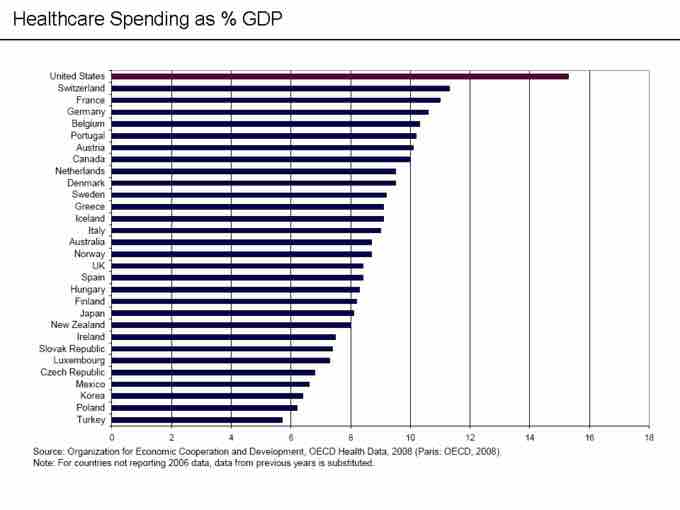Background
Health care in the United States is provided by many distinct organizations. Health care facilities are largely owned and operated by private sector businesses. The government primarily provides health insurance for public sector employees. 60-65% of healthcare provision and spending comes from programs such as Medicare, Medicaid, TRICARE, the Children's Health Insurance Program, and the Veterans Health Administration. Their family member's employer insures most of the population under 65, some buy health insurance on their own, and the remainder is uninsured.
In May of 2011, the state of Vermont became the first state to pass legislation creating a single-payer health care system. The legislation, known as Act 48, establishes health care in the state as a "human right" and lays the responsibility on the state to provide a health care system which best meets the needs of the citizens of Vermont. The state is currently in the studying phase of how best to implement this system.
The Patient Protection and Affordable Care Act (PPACA), commonly called Obamacare (or the federal health care law), is a United States federal statute signed into law by President Barack Obama on March 23, 2010. Together with the Health Care and Education Reconciliation Act, Obamacare represents the most significant regulatory overhaul of the U.S. healthcare system since the passage of Medicare and Medicaid in 1965.
PPACA is aimed primarily at decreasing the number of uninsured Americans and reducing the overall costs of health care. It provides a number of mechanisms—including mandates, subsidies, and tax credits—to employers and individuals in order to increase the coverage rate.
Spending
According to the World Health Organization (WHO), total health care spending in the U.S. was 15.2% of its GDP in 2008, the highest in the world . The Health and Human Services Department expects that the health share of GDP will continue its historical upward trend, reaching 19.5% of GDP by 2017. Of each dollar spent on health care in the United States, 31% goes to hospital care, 21% goes to physician/clinical services, 10% to pharmaceuticals, 4% to dental, 6% to nursing homes and 3% to home health care, 3% for other retail products, 3% for government public health activities, 7% to administrative costs, 7% to investment, and 6% to other professional services (physical therapists, optometrists, etc.).

International Comparison for Healthcare spending as % GDP
This graph shows the fraction of gross domestic product (GDP) devoted to health care in a number of developed countries in 2006.According to the Organization for Economic Cooperation and Development (OECD), the United States spent 15.3 percent of its GDP on health care in 2006.The next highest country was Switzerland, with 11.3 percent.In most other high-income countries, the share was less than 10 percent.
Increased spending on disease prevention is often suggested as a way of reducing health care spending. Whether prevention saves or costs money depends on the intervention. Childhood vaccinations, or contraceptives save much more than they cost. Research suggests that in many cases prevention does not produce significant long-term cost savings. Some interventions may be cost-effective by providing health benefits, while others are not cost-effective. Preventive care is typically provided to many people who would never become ill, and for those who would have become ill, it is partially offset by the health care costs during additional years of life.
Private Healthcare
Most Americans under age 65 (59.3%) receive their health insurance coverage through an employer (which includes both private as well as civilian public-sector employers) under group coverage, although this percentage is declining. Costs for employer-paid health insurance are rising rapidly: since 2001, premiums for family coverage have increased 78%, while wages have risen 19% and inflation has risen 17%, according to a 2007 study by the Kaiser Family Foundation. Workers with employer-sponsored insurance also contribute; in 2007, the average percentage of premium paid by covered workers is 16% for single coverage and 28% for family coverage. In addition to their premium contributions, most covered workers face additional payments when they use health care services, in the form of deductibles and copayments.
Public Healthcare
Government programs directly cover 27.8% of the population (83 million), including the elderly, disabled, children, veterans, and some of the poor, and federal law mandates public access to emergency services regardless of ability to pay. Public spending accounts for 45% to 56.1% of U.S. health care spending.
There are also various state and local programs for the poor. In 2007, Medicaid provided health care coverage for 39.6 million low-income Americans (although Medicaid covers approximately 40% of America's poor). Also in 2007, Medicare provided health care coverage for 41.4 million elderly and disabled Americans. Enrollment in Medicare is expected to reach 77 million by 2031, when the baby boom generation is fully enrolled.
It has been reported that the number of physicians accepting Medicaid has decreased in recent years due to relatively high administrative costs and low reimbursements. In 1997, the federal government also created the State Children's Health Insurance Program (SCHIP), a joint federal-state program to insure children in families that earn too much to qualify for Medicaid but cannot afford health insurance.